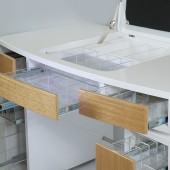DESIGN NAME:
isobel by Brendan
PRIMARY FUNCTION:
Dressing Table
INSPIRATION:
My wife, Isabelle, wanted a dressing table. We searched everywhere for one, but couldn't find anything suitable, so I decided to design and build one for her.
UNIQUE PROPERTIES / PROJECT DESCRIPTION:
The dressing table is contemporary in design - minimalism embedded with high tech sophistication. It is innovative in material usage, combining MDF, timber veneer and clear acrylic.
All drawer fronts are made of timber veneer and polished to a glass-like finish, which are also free of any knobs resulting in a clean and sleek look. The slightly curved table front together with the high gloss 2 pack white polyurethane finish add a touch of elegance.
Proximity sensors are hidden within all drawer fronts and the tabletop lid. Each one of them will detect an operator's hand approaching (in the process of executing an 'open' action) and will trigger the relevant circuitry which will subsequently activate a mechanism to 'pop-open' the intended drawer/lid. LED lights are also incorporated into the drawers and will automatically turn on when opened.
Lighting is very important to facilitate the make-up process, thus incorporating a light square ring around the mirror with colour-corrected LED strips, will give shadowless glow to the face when looking into the reflection. There are also two levels of selectable brightness, which is handy for different occasions.
The two base units and the tabletop portion are held together by stainless steel stand-offs. Four caster wheels are also discreetly enclosed on the bottom of the two base units, allowing for easy relocation.
The hinges holding the heavy lid to the correct angle also provide a soft closing action, which is crucial for yielding a safe return to the closing position.
OPERATION / FLOW / INTERACTION:
-
PROJECT DURATION AND LOCATION:
-
FITS BEST INTO CATEGORY:
Furniture Design
|
PRODUCTION / REALIZATION TECHNOLOGY:
The design was firstly done as a 3D model, with CAD drawings. The two base units and the table top are made of 25mm thick MDF. All the separate panels that made up these three units, are accurately drawn to scale in CAD and then cut up on a CNC machine. These panels are then joined up accordingly using a biscuit jointer All edges are round off and sand down before being sprayed with high gloss 2 pack white polyurethane.
The curved drawer fronts are made up of 4 layers of 3mm Australian Oak plywood, glued together using a curve template (which was also made using CNC parts). These drawer fronts are then polished to a glass-like finish with coats after coats of clear polyurethane.
6mm acrylic was chose as the material to make the drawers and storage units, because they were quicker to fabricate. Other than the edges needed to be polished, they didn't require any treatment or finish. They are relatively more stable and durable than other material with the same thickness.
The process of making the dressing table is well thought out with every piece of the puzzle accurately defined, therefore repeatability is quite feasible. Making the next ten would be much easier than the first one.
I plan to tweak the the design and create three to six different variations, including different sizes, colours and functions.
SPECIFICATIONS / TECHNICAL PROPERTIES:
Size: Length 1200mm, Depth 600mm (650mm front of curve), Height: 730mm
TAGS:
isobel, contemporary dressing table, vanity desk,
RESEARCH ABSTRACT:
-
CHALLENGE:
-
ADDED DATE:
2013-02-25 22:56:35
TEAM MEMBERS (1) :
Brendan Wong
IMAGE CREDITS:
Brendan Wong, 2012.
|









